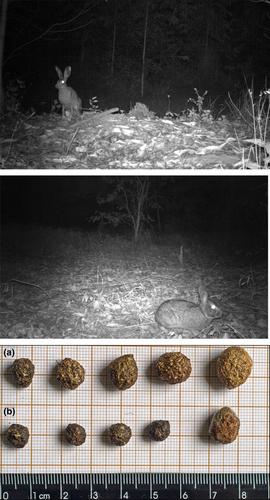当前位置:
X-MOL 学术
›
Ecol. Evol.
›
论文详情
Our official English website, www.x-mol.net, welcomes your
feedback! (Note: you will need to create a separate account there.)
DNA mini-barcoding of leporids using noninvasive fecal DNA samples and its significance for monitoring an invasive species.
Ecology and Evolution ( IF 2.3 ) Pub Date : 2020-06-05 , DOI: 10.1002/ece3.5863 Nayra T Rodrigues 1 , Bruno H Saranholi 1 , Thais A Angeloni 1 , Nielson Pasqualotto 2, 3 , Adriano G Chiarello 3 , Pedro M Galetti 1
Ecology and Evolution ( IF 2.3 ) Pub Date : 2020-06-05 , DOI: 10.1002/ece3.5863 Nayra T Rodrigues 1 , Bruno H Saranholi 1 , Thais A Angeloni 1 , Nielson Pasqualotto 2, 3 , Adriano G Chiarello 3 , Pedro M Galetti 1
Affiliation

|
Introduced in South America at the end of the 19th century, the European hare population has expanded dramatically and now represents a risk to native Brazilian forest rabbits. Monitoring the invasive Lepus europaeus and its coexistence with native Sylvilagus brasiliensis is a challenge that can be efficiently addressed by the use of molecular tools. This work describes a set of primers useful for amplifying three mini‐barcodes for the molecular identification of both invasive and native leporid species using degraded fecal DNA. In addition, tests in silico indicate that these mini‐barcodes can successfully amplify the DNA sequences of a number of leporids. These mini‐barcodes constitute a powerful tool for the monitoring and management of the invasive L. europaeus and the conservation of native rabbits.
中文翻译:

使用非侵入性粪便 DNA 样本对兔科动物进行 DNA 迷你条形码编码及其对监测入侵物种的意义。
欧洲野兔于 19 世纪末引入南美洲,数量急剧增加,现在对巴西本土森林兔构成了威胁。监测入侵的欧洲天兔及其与本地巴西兔的共存是一项挑战,可以通过使用分子工具有效解决。这项工作描述了一组引物,可用于扩增三个迷你条形码,以便使用降解的粪便 DNA 对入侵和本地豹纹物种进行分子鉴定。此外,计算机测试表明这些迷你条形码可以成功扩增许多兔科动物的 DNA 序列。这些迷你条形码构成了监测和管理入侵性欧洲乳杆菌以及保护本地兔子的强大工具。
更新日期:2020-06-26
中文翻译:

使用非侵入性粪便 DNA 样本对兔科动物进行 DNA 迷你条形码编码及其对监测入侵物种的意义。
欧洲野兔于 19 世纪末引入南美洲,数量急剧增加,现在对巴西本土森林兔构成了威胁。监测入侵的欧洲天兔及其与本地巴西兔的共存是一项挑战,可以通过使用分子工具有效解决。这项工作描述了一组引物,可用于扩增三个迷你条形码,以便使用降解的粪便 DNA 对入侵和本地豹纹物种进行分子鉴定。此外,计算机测试表明这些迷你条形码可以成功扩增许多兔科动物的 DNA 序列。这些迷你条形码构成了监测和管理入侵性欧洲乳杆菌以及保护本地兔子的强大工具。











































 京公网安备 11010802027423号
京公网安备 11010802027423号